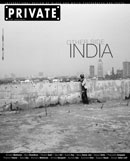
Buy PRIVATE 43
[W]henever people talk about ‘Indian photography’ it obviously leads to a debate and discussion about how appropriate it is to term it as ‘Indian photography’ rather than ‘photography in India’. The question is: to what extent has photography in India been Indianized?
Photography in this part of the world was a powerful tool and a colonial construct, being intertwined with and inseparable from the power structure of the British colonial rule. Photography in India has a long history, a history of domination and denial of the ‘Other’ culture. It was used as an administrative aid and an anthropological tool by the British colonial regime, thus negating the presence of the ‘Other’ culture. Control and conflict have always been embedded in the culture and history of Indian civilization, but what is new in the present context of the Indian civilization is that some ‘power culture’ has been targeting the ‘Other’ cultures, turning society into a bloody clash of civilizations. India, like many other countries, is going through difficult times. Most Indians believe in being tolerant and cherish the awesome beauty of the country’s diversity. Despite the diversity in all spheres of life, conflict is bringing intolerance and even artistic freedom is being challenged. Photography is also in danger.
During a recent lecture in Italy I was trying to establish whether a photograph is the illusion of a literal description of how the camera freezes a fragment of time and space. And perhaps the discussion led to the effort in coordinating the Indian photographers in order to contribute to PRIVATE magazine. Such effort is a cross-product of several minds that have not escaped the restrictions of present time and space. The contributing photographers have addressed the complex nature of the time and space evolving around the formation of an identity through works that have crucially explored the issues of marginalization and dislocation. When you talk about marginalization and dislocation it is quite relevant to include dialogues from Kashmir, where thousands have died and thousands live in the shadow of death.
Whether it’s Prabuddha Dasgupta’s introspection of ‘Myth & Memory’ or Prashant Panjiar’s documentation on Ayodhya, or the work by any other photographer who has contributed to this magazine, one common thing stands out: images shine through in their testimonies, which allow us to explore, communicate and experience.
All these photographers belong to the Majority World, who challenges western power, which has been utilizing the camera as a highly politicized tool. Again, a tool negating indigenous photography.
Drik India agency claims that ‘Majority World’ should be used as a replacement for such political expressions as ‘Developing World’, ‘Third World’, or ‘Global South’.
The works included in this issue define the culture of India, knowledge of the country, speak various languages with an innate understanding of the dynamics of Indian society, resulting from inside and outside forces.
(Suvendu Chatterjee)
Title: Other side India § Publication: Winter 2008 / Softcover / 84 pages / 21×26cm § Photographers: Arindam Mukherjee, Bijoy Chowdhury, Faheem Qadri, Gauri Gill, Kushal Ray, Manoj Kumar Jain, Nilayan Dutta, Prabuddha Dasgupta, Prashant Panjiar, Saibal Das, Shantanu Mukherjee, Srinivas Kuruganti, Sucheta Das, Sudharak Olwe, Swapan Nayak, Zishaan Akbar Latif § Writers: Jiban Narah, Mamang Dai, Navkirat Sodhi, Rati Saxena, Savita Singh, Sukrita Paul Kumar § Introduction by: Suvendu Chatterjee.








